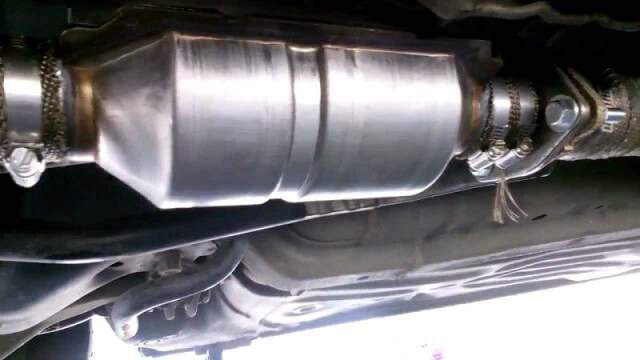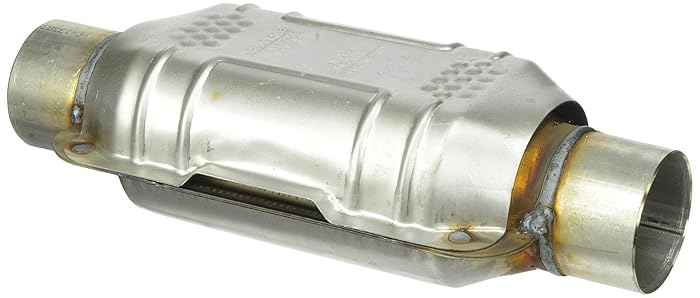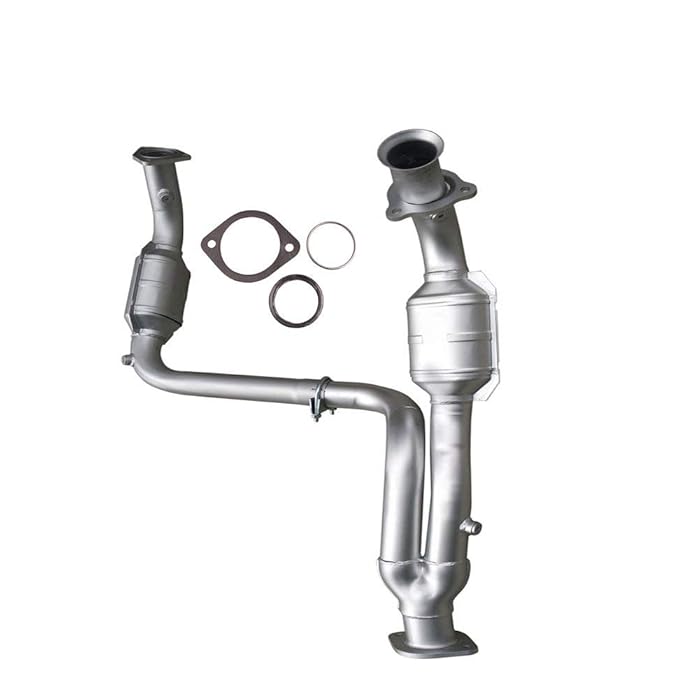If you’re reading this, it means your car needs a new catalytic converter. With that being said, you have come to the right place. We listed the best aftermarket catalytic converters for your car. But in truth, it’s not about choosing the best. You should be more concerned about choosing the right unit.
What Is A Catalytic Converter?

Not all vehicles are the same, but they all have catalytic converters. All 1996 and newer vehicles are OBD2 compliant and are equipped with catalytic converters. This holds true regardless if the vehicle has a gasoline or diesel engine.
Without the catalytic converter, your modern vehicle will refuse to start. In some cases, it may start but run poorly at the expense of dismal fuel economy. This is because the catalytic converter is more than just an expensive metal shell. It is responsible for converting the toxic fumes of combustion from toxic to not-so-toxic. From a scientific point of view, the catalytic converter combines toxic hydrocarbons and carbon monoxide with oxygen. The result is a mishmash of carbon dioxide and water exiting the tailpipe.
What Are The Symptoms Of A Bad Catalytic Converter?

Via www.cars.com
Truth be told, the catalytic converter in your vehicle was designed to last a long time. And by this I mean it is designed to last the life of your car. But external forces and internal engine problems can deteriorate the performance and longevity of the catalytic converter.
The primary symptom of a bad, broken, failing, or deteriorating catalytic converter is a check engine light or MIL (Malfunction Indication Lamp). This is followed by poor performance, sluggish acceleration, engine misfires, and increased emissions. The check engine light is accompanied by an OBD2 fault code or trouble code. In the case of the catalytic converter, the trouble code is P0420. The technical meaning of P0420 code is Catalyst System Efficiency below Threshold in Bank 1.
In some cases, there might be more than one trouble code. The P0420 code may be accompanied by other related trouble codes such as P0421, P0422, and P0423.
8 Best Catalytic Converters Reviewed
**Below, you’ll find our more detailed reviews, but you can also click the links above to see current prices or read customer reviews on Amazon.
1. Flowmaster 3” Inlet/Outlet Catalytic Converter
Flowmaster is one of the best brands in vehicle exhaust systems. This 3” catalytic converter is 49-state legal and is designed to meet federal EPA emission requirements. It features a stainless steel outer shell and an internal substrate material to provide maximum efficiency without restricting flow.
However, this catalytic converter is not ideal for use in emission restrictive states. It is also non-CARB compliant, so you better take this into consideration. But for the $70 price, it’s hard to find a better catalytic converter with better flow characteristics than the Flowmaster.
Pros
- Affordable price
- Legal in 49 U.S. states
Cons
- Welding/cutting is required for installation
2. Walker EPA Certified Catalytic Converter
The Walker 16468 catalytic converter is designed for use on 1996 and newer OBD-compliant vehicles. It features thicker OEM-style flanges, hangers, and brackets for maximum strength. It is constructed from a stainless steel and aluminized shell. It even comes with a built-in heat shield to enhance durability.
But what makes the Walker catalytic converter special is the direct flange-to-flange design. The exhaust inlet connection is a 3-bolt welded flange while the exhaust outlet connection is a 2-bolt welded flange. This design ensures zero leaks and reliable performance.
Pros
- Durable build quality
- Flange-to-flange design
- Easy to install
Cons
- It’s pricier than other units
3. Magnaflow 99205HM Universal Catalytic Converter
With a stainless steel construction and Federal emissions compliant design, the Magnaflow 99205HM is one of the best and most affordable universal-fit catalytic converters for modern OBD2 vehicles.
This Magnaflow catalytic converter is good for both gasoline and diesel-fed motors. It features seam welded construction to ensure lasting durability. Best of all, this catalytic converter is proudly made in the USA!
Pros
- Great build quality
- Affordable price
- Stainless steel body
Cons
- Requires welding/cutting to install
4. Walker 16370 Direct Fit Catalytic Converter
When it comes to building quality, it is hard to fault the Walker 16370. It has a flange-to-flange design that bolts directly to the OEM exhaust piping. It is crafted from a stainless steel and aluminized body. It also comes with pipe heat shields to add an extra layer of durability.
But Walker 16370 is a bit pricey at $151. But with thick OEM style flanges, premium substrate materials, and precise catalyst loading, you ultimately get what you pay for.
Pros
- Superior build quality
- OEM style flanges for a precise fit
Cons
- It’s pricier than other units
5. Eastern 70318 Catalytic Converter
If you’re looking to save money on a new catalytic converter, take a closer look at the Eastern 70138. This is a non-CARB compliant catalytic converter that is intended for all OBD2-equipped vehicles. But this doesn’t mean the unit is an exact fit in any type of car. With 2.5” piping for the inlet and outlet, this converter is perfect for vehicles running a 2.5” exhaust system.
And with prices starting at less than $45, the Eastern 70138 Catalytic Converter is the top choice for budget-oriented buyers.
Pros
- Great low price
- Nice build quality
Cons
- Needs welding/cutting to install
6. MOSTPLUS Front Exhaust Manifold and Catalytic Converter
This manifold/catalytic converter is specifically designed to fit the 2002-2006 Nissan Altima 2.5L and 2002-2005 Nissan Sentra. This MOSTPLUS kit is an OEM catalytic converter that includes the exhaust manifold. The reason why it belongs in this list of best catalytic converters is the price.
It starts at less than $90. When you consider this kit includes the catalytic converter and exhaust manifold, paying less than $100 is a super deal. If you have a late model Nissan Altima or Sentra, look no further than MOSTPLUS for a new catalytic converter.
Pros
- Exact OEM fit to Nissan Altima and Sentra
- Includes catalytic converter and exhaust manifold
- Low and friendly price
Cons
- None so far
7. Yonaka 2.5” ID Ultra High Flow Catalytic Converter
The Yonaka 2.5” High Flow Catalytic Converter is designed and engineered for the performance enthusiast. However, this kit is strictly for off-road or racing applications only. The great thing about this unit is the built-in O2 sensor bung. This prevents the nasty check engine light from turning ON when tuning your ride.
The Yonaka catalytic converter has an inlet/outlet diameter of 2.5”. It is crafted from high-quality stainless steel and an all-metal core for lasting durability and exhilarating performance. Best of all, this cat is recommended for up to 5.7-liter engines with high horsepower and torque outputs.
Pros
- Offers better flow than OEM cats
- Stainless steel construction
- Improves horsepower and torque
Cons
- Higher price
8. Autosaver88 Front Catalytic Converter and Exhaust Manifold
This kit is an OEM catalytic converter and exhaust manifold designed to fit GM trucks and SUVs. Examples are the 2002-2005 Chevrolet Avalanche, 1999-2005 Chevy Silverado, and 2000-2006 Chevy Tahoe and Suburban. This kit is also good for the 1999-2005 GMC Sierra 1500 and 2002-2005 Cadillac Escalade 5.3L.
Best of all, this catalytic converter kit is a direct-fit and high-flow alternative to the stock cats. It comes with OEM spec flanges and directly bolts to the existing exhaust with no special tools required. It even comes with a genuine federal EPA certification and is backed by a 5-years or 50,000-miles limited warranty.
But since this is a complete kit, it does cost a bit more than the usual catalytic converter.
Pros
- Stainless steel construction
- OEM quality flanges for a direct fit
- Federal EPA-certified quality
Cons
- It’s expensive
How To Choose A Catalytic Converter
There are two things to consider when choosing a new catalytic converter. First, are you dealing with a stock or tuned vehicle? Next, what is the diameter of the exhaust piping? You should also consider if the existing exhaust piping is OEM or aftermarket. Some vehicles that came with stock 2.5-inch piping might do better when upgraded to a new set of 3” pipes when fitting a turbocharger or supercharger.As you can see from our list of the best catalytic converters above, there are some units that are designed specifically for the make and model of a particular vehicle. But you can safely choose a universal-fit catalytic converter as long as the diameter of the inlet and outlet pipes are an exact match to the current exhaust system.
How To Check For A Bad Or Failing Catalytic Converter

The truth is it’s hard to tell if your catalytic converter is failing or not. Besides the fact that you can’t judge the performance of the catalyst by simply looking or removing it, it happens to be located underneath the vehicle, which also makes it hard to access.
The only way to tell if a catalytic converter is going bad is to remove it from underneath the vehicle and cut/open/break it in half. Unfortunately, it is highly illegal to do that in most states.
But if you have an OBD2 scan tool, you can easily check the condition of the catalytic converter. The trick is to observe the live data on both the upstream and downstream oxygen sensors. In a vehicle with a working catalytic converter, the upstream O2 sensor reading should be fluctuating from rich to lean and vice versa at idling speed. The downstream O2 sensor readings should also be steady at this point.
Now, it’s time to rev the vehicle. Press the gas pedal to increase the engine speed. If you notice the downstream O2 sensor readings are fluctuating as you increase or decrease the idling speed, you are most likely dealing with a broken or burned out catalytic converter.
Is It Possible To Clean A Catalytic Converter?

Via www.youtube.com
In some cases (or if the fault is caused by excessive blockage or contamination), cleaning the catalytic converter will erase the check engine light and P0420 trouble code. But then again, this is not always the case. When the catalytic converter goes bad, the next best thing is to replace it with a new unit.
But you can still try cleaning the converter and see if it’s enough to erase the MIL in the console. In order to do that, you’ll need to remove the catalytic converter from the exhaust piping. This will also allow you to physically check and inspect the housing to see if there are cracks or holes.
Dip and soak the whole unit in a small bucket of soapy water. Dish soap is preferred although you can also use a strong all-purpose cleaner or degreaser. Let the catalytic converter soak for an hour or more and rinse well with clean water. Let it dry before installing. If the problem is caused by excess gunk or blockage, cleaning the converter might solve the issue.
On the other hand, the presence of thick gunk or contaminants in the catalytic converter could be a sign of a serious engine problem. Broken head gaskets can introduce oil and coolant inside the combustion chamber, which is burned together with the air and gasoline. The contaminants make their way into the exhaust stream and straight inside the catalytic converter. When this happens, the converter won’t be able to do its job since it is designed to accommodate exhaust gasses from air and gasoline only. Oil, chemicals, and other liquids will only harm or damage the converter.
Can I Drive A Vehicle Without A Catalytic Converter?
It depends. Most of the OBD2-compliant vehicles have O2 sensors located before the catalytic converter. The ECU utilizes the O2 sensor readings to adjust the required air/fuel ratio inside the engine. What this means is you can drive the vehicle without a catalytic converter, but it doesn’t mean you should.
But in more modern cars, the exhaust is equipped with two O2 sensors: one in the inlet and one in the outlet flange. If your car has this design, it may prevent you from driving the vehicle if you remove the catalytic converter.









